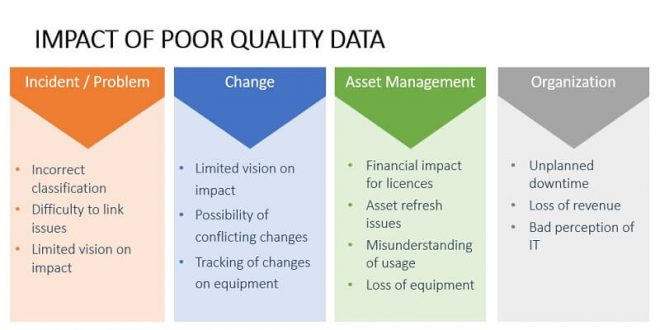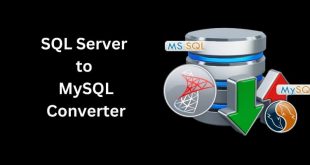Everyone knows the phrase garbage in, garbage out. A poor quality input will always result in poor quality outputs no matter what field you are in this is a great saying and it needs to be followed. However, in the case of CMDB, it is especially true. It is almost impossible for an IT organization to make an informed decision, provide a superior user experience, and deliver services efficiently without the help of high-quality data flowing through their system. This being said it is no surprise that a key concern among most IT leaders is the accuracy of IT data and the risk of suspect data. This is even truer when there are very high stakes involved in the process.
When you look at it form an ITSM perspective, incorrect data can have a massive impact on the efficiency, governance, cost, and security of your service.
There are four significant areas in which poor data can be a challenge to the POI of your ITSM software
Incident or Problem Management
Having data that is of poor quality or which is outright inaccurate in your CMDB can cause incorrect classification of data. This is not about how everyone classified a category in his or her problems or incidents section of the ITSM tool. This issue arises in the second layer of classification that may outline what can happen due to a problem or incident. When you have outdated data or misinformation filled in your CMDB, you will have minimal visibility of what can be the impact of this wrong data, and it can be challenging for you to find a way to link these problems or issues and come up with the root cause of the problem. On the other hand, if your CMDB has accurate information and correct links to other relevant data it can be easy for you to understand what the impact of a particular problem or incident will be on the different systems in your organization.
Change Management
Like in the case of an incident and problem management you will have very limited visibility of the impact of the change carried out in your organization if you do not have the right data in the CMDB. Take a simple example of if you wanted to make a change but it conflicts with a change made by someone else. In this case, neither your change or the change of the other person would have the desired effect. With the help of accurate data in the CMDB, you would be able to see the impact that your change will have and whether or not you will be able to carry out both the changes together. It also makes keeping track of your changes on any equipment easier. At some point of time you or a supervisor may want to know how many changes have been made on that piece of equipment this helps to see the repairs that have been done in the lifecycle of a faulty device. It is crucial that your CMDB accurately tracks all information about a change.
Asset Management
Poor data quality can be a big issue in terms of ITAM for many reasons, but the most important of these is regarding financial impacts, misunderstanding of usage, asset refreshing, and the loss of equipment. If your CMDB has incorrect data, you will not be able to provide an accurate financial impact from the usage of your license. In addition, you may not know which assets you already have in the field and how they impact each other which will, in turn, become another issue when it is time for you to change or replace the equipment. If you misunderstand the usage of your equipment and who is using your equipment and when it is used you may come across a big issue when any of this needs to be refreshed. Last but not least it is shocking how easily you can lose track of expensive equipment when you lack quality data and a proper discovery tool.
Organization
There can be a significant organizational impact that is related to poor quality data. If you make conflicting changes no matter how intentional it can result in unplanned downtime. This downtime will intern result in the loss of revenue either directly or indirectly. One great example of this would be in the manufacturing world where a single bad change could turn into a horrific nightmare for the production team. As a consequence, any unplanned downtime that has a negative impact on the business and the revenue will give the customers a bad perception of its IT.
Now that you know the consequence of having incomplete or bad data flowing through the CMDB it is recommended that you constantly check the quality of your existing data. Periodically getting rid of any bad data and updating any data entries that are incomplete can help you maintain high-quality CMDB data. If you are new to data management, you can find many blogs and webinars that can teach you best practices in your industry and give you tips to successfully adapt your CMDB, help you with a tool selection criteria and also teach you about automated discovery methods.
 Free Web Resources , psd, mockups, & web templates Best WordPress Themes & Best Html Templates
Free Web Resources , psd, mockups, & web templates Best WordPress Themes & Best Html Templates








